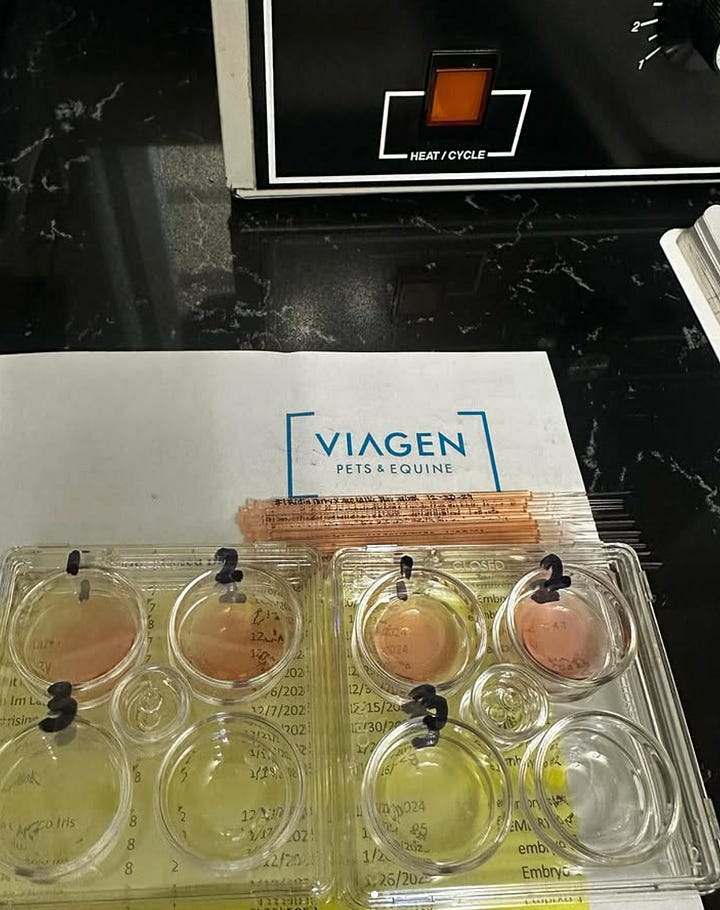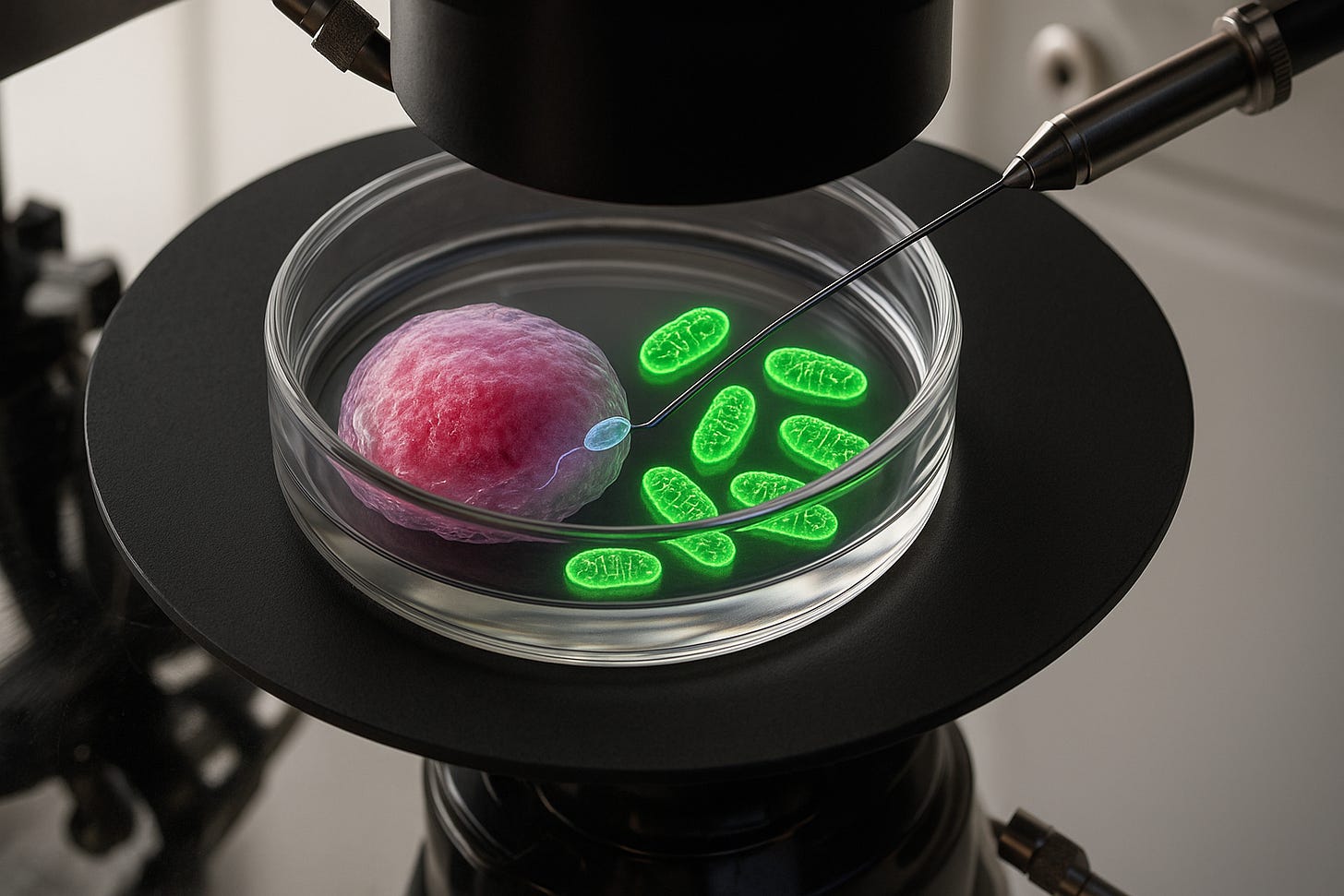>FASTA_22: Eggs!
ViaGen clones polo mares; Threesome IVF babies; In-ovo matriarchy now in stores; Helania’s athletic lactoferrin; Kascaid wants your interstitial fluids; Big pharma's pledge for US biomanufacturing...
>FASTA: weekly short reads of the global biotech ecosystem | Papers and patents, acquisitions and bankruptcies, biotech philosophy | Read in under 5 min | Follow on LinkedIn, X, and now Instagram too! | Versión en Español
Pilgrim is proud to sponsor >FASTA! We’re developing the next generation of military medicine to meet the operational demands of modern warfare—moving beyond theory and bringing biotechnology from the benchtop to the battlefield.
1/10: ViaGen clones polo mares 🐎
Adolfo Cambiaso, an Argentinian polo legend, had dreamed of cloning his fast and agile mare to secure the future of his children in the sport. Upon realizing that even just a son (not a clone) was worth USD $760k at auction, a longtime friend of his suggested they join forces to keep the bloodline in their hands. Together with Crestview founder, Alan Meeker — who contracted the world’s leading pet cloning company, ViaGen — they made fortunes.
Well, that was only until Meeker sold three clones behind his BFF’s back for $2.4 million dollars to pay a $1.4 million debt from his other biotech company. Cambiaso sued him and got the clones back, but who knows, maybe some tissue samples from his precious mare are in some cryopreservation facility, ready to flood polo tournaments.
A truly fascinating story! Even more enticing is to think about how much more fun and money are waiting for biotech builders who know how to look beyond pharma and techbio. I call it for 2028 to be the year we experience the first enhanced [polo] games: get ready to bet on-chain for the best gene mods, folks, F1 of biotech is about to get wild.


2/10: Threesome IVF babies 🧫
If someone’s ever told you it’s impossible for threesomes to procreate, tell them that more than 8 babies have already been born carrying the DNA of three parents each, since the 90s. If you are that someone, you should also know this was not done “for fun in the natural way”, but through IVF which aimed to prevent mitochondrial mutations from passing on to the children.
Have you ever separated egg yolk from the whites? This is similar: choose the least sexy but still healthy person to donate an egg. Remove its nucleus (sorry) and don’t forget to keep its mitochondrial DNA intact (in the “whites”). Then, replace it with the nucleus of the sexy and healthy egg. Finally, fertilize it with the sperm (hopefully equally sexy and healthy) in vitro, and boom, you’ll soon be parents to a healthy and sexy baby!
Grandma’s advice is to be very careful when you’re scooping out nuclear DNA from the sexy egg so you don’t carry any undesired mtDNA along. For very mysterious reasons though, embryos that had 1% of this undesired mtDNA were born with 30-60% of that DNA, a phenomenon scientists now call “MRT reversion”.

3/10: In-ovo matriarchy now in stores 🐣
In the US alone, 350 million male chicks are slaughtered each year because, well, females are the productive ones here. Using techniques like hyperspectral imaging of the egg, hormone detection from the egg fluid, or PCR analysis of the sex chromosome, companies like NestFresh and Kipster are selecting for female eggs only, without killing any male chicks. Despite the higher price, 73% of American consumers show interest in buying eggs made in this way.

4/10: Helania’s athletic lactoferrin 🍼
Lactoferrin is a complex protein found in mammalian milk and other bodily secretions, that plays a key role in immunity and iron transport. While most still think of it in the context of breast milk for babies, Helania sees an opportunity to apply lactoferrin’s anti-inflammatory and gut health powers to adult supplements.
Compared to bovine lactoferrin, which is expensive and in short supply, human lactoferrin has been shown to prevent an immune response in clinical trials, which means it can stay in the body and confer its benefit.
Back in 2022, I interviewed the Product Head of Turtle Tree, a Singapore-based company that produces breast milk ingredients through precision fermentation, including lactoferrin. Last year, they secured a partnership with Cadence Performance Coffee for a line of cold brew espresso shots infused with their lactoferrin powder. You can listen to the episode in Spanish here →
5/10: Kascaid wants your interstitial fluids 👀
When thinking about biomarkers and biosensors, most people can only think of blood. You Biopunks should know that there’s a fluid called interstitial fluid that surrounds your cells— where nutrients, hormones, and waste diffuse — that can be used to monitor biomarkers more frequently and less invasively, without needless needles!
Kascaid is building such a biosensor, focusing first on immune biomarkers for clinical trials, where more convenient and frequent sampling can reduce dropout rate and enable richer data with smaller and faster studies. Their vision is to use these biosensors in wearables like Apple Watch, Oura Ring, and Whoop to get continuous biodata that wouldn’t be possible to capture otherwise.
6/10: AstraZeneca pledges $50M for US biomanufacturing 💵
The US accounted for more than 40% of AstraZeneca's annual revenue in 2024. Since Trump wants to reshore baby reshore, the company plans to build a new Virginia plant, and expand in Maryland, Texas, and Massachusetts. Roche, Sanofi, Eli Lilly, J&J, and Novartis have made similar commitments.
7/10: Puna Bio goes international with the Gates Foundation 🦠
The first Argentinian investment for the foundation will be used to help sub-Saharan and South Asian farmers boost yields, reduce fertilizer use, and grow crops on degraded soils using their extremophile microbes.
8/10: Plants vs microplastics 🌱
Polysaccharides derived from fenugreek and okra fruits removed up to 89% of microplastics from water, outperforming polyacrylamide, the synthetic chemical that is currently standard in water treatment facilities. In 30-60 minutes, the plants’ polysaccharides formed bridges between microplastic particles without generating harmful byproducts.
9/10: Alphagenome 🧬
Google’s AI model uses the same transformer architecture as ChatGPT to predict the effects of single DNA variants. It takes up to 1 million bp as input, and outputs predictions of thousands of properties, like RNA expression, splicing, DNA accessibility, histone modifications, TF binding, polyadenylation causality, enhancer linking, and chromatin contact maps.
10/10: Augmentation Lab's Hacker Houses 🧠
Not news, but I found this to be very cool: “A transdisciplinary community of philosopher-builders developing technologies to enhance the human condition. 20 residents — hardware/software hackers, creative coders, bio-tinkerers, kinetic sculptors — share Cambridge hacker houses during the summer. By day, they turn wild concepts into working prototypes; by night, they dissect meaning and ethics over midnight pizza” — Someone please invite meee!!
Poets: fresh essays on biotech, across the tree of life.
What happened to DAOs?
In light of the recent funding cuts to the NIH, the CDC, and the NSF, great pieces have been written on how the social contract established post-WWII built the scientific institutions we know, the limitations it presents to generating more scientific breakthroughs, and where we could be going next.
In this post, I want to focus on the Decentralized Science (DeSci) movement that once promised to change how science is done and enable all kinds of new research that wouldn’t be possible under the old dogma. Four years post-hype, I have a very simple and pragmatic question: what have these rebellious scientists and technologists actually achieved?








